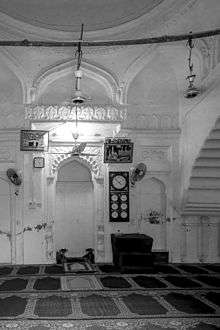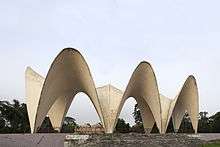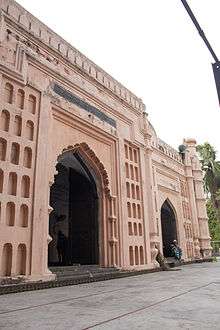Mausoleum of three leaders

The Mausoleum of three leaders (Bengali: তিন নেতার মাজার) is a significant architectural monument located at Shahbag, Dhaka in Bangladesh. The monument hosts the graves of three pre-liberation politicians from Bengal in the 20th century- A.K. Fazlul Huq (1873–1962), Huseyn Shaheed Suhrawardy (1892–1963) and Khwaja Nazimuddin[1] (1894–1964).[2] All three men served as the Prime Minister of Bengal in British India.





The monument was designed by architect Masood Ahmed and S.A. Zahiruddin and was established in the year 1963. The style of architecture of the monuments is an interpretation of Islamic Arcs.


Location
The Mausoleum of three leaders is located in Suhrawardy Udyan in Shahbagh across from the Doyel Chattar near Dhaka University. The exact geographic coordinates of the location is Latitude: 23°43'44"N and Longitude:90°23'59"E. There are many historical buildings and sites on the area that the Mausoleum of three leaders is located such as;
- Shahbaz Khan Mosque
- Bangla Academy
- Curzon Hall
- Dhaka University Science Library
- Dhaka University Science Complex
- Dhaka University Department of Microbiology
- Ramna Kali Mandir
- Bangladesh Sishu Academy
- Dhaka Gate
- Center for Renewable Energy
- Center for Advanced Research in Sciences
- Doyel Chattar
History
The Mausoleum of three leaders was established in the year 1963. It was built by architects Masood Ahmed and S.A. Zahiruddin. The Mausoleum of three leaders consists of a hyperbolic paraboloid structure that is erected over the three graves of the three political leaders. The three political leaders being A.K. Fazlul Huq, Huseyn Shaheed Suhrawardy and Khawaja Nazimuddin.[1] The three leaders had died in separate dates but were all buried in the same area as all three of them had contributed significantly to East Pakistan and were all involved politically. A.K. Fazlul Huq was a very well known politician who was famous for his leadership qualities. One of his most important contributions was being involved with the Bengali Language Movement. Fazlul Huq along with Huseyn Suhrawardy had engaged in many political acts such as forming the United Front in the 1954 elections, with which they had gained victory by winning the most seats. Huseyn Suhrawardy and Fazlul Huq had also worked together to control the government of East Pakistan. However, it was rumored that Suhrawardy and Fazlul Huq had rivalry between them which had caused Fazul Huq to step down from politics. Suhrawardy was known to be the founder of the Bangladesh Awami League. He was also known to contribute significantly to the growth and development of East Pakistan. Suhrawardy became the Prime Minister of Pakistan in 1956 but was forced to resign in 1957. He was completely banned from politics by Ayub Khan (President of Pakistan). Khawaja Nazimuddin was the Prime Minister of Pakistan from 1951 to 1953. Suhrawardy had served as the Minister of Labor and also the Minister of Civil Supplies under Khawaja Nazimuddin. Even with all these achievements, it was rumored that these three political leaders had a rivalry with each other in terms of success. However, despite their rivalry, three of the political leaders were buried under the same roof of the mausoleum of the three leaders. [5][6][7]
Present day
In the present day, the Mausoleum is sometimes open to the public. In certain events such as the death anniversary of either A.K. Fazlul Huq, Huseyn Suhrawardi or Khawaja Nazimuddin, special prayer ceremonies are taken place in the site of the mausoleum and people bring in flowers to commemorate.
References
- 1 2 "দিল্লির সিংহাসনে প্রথম বাঙালি এবং তাঁর ভূমিকা | মতামত". Opinion.bdnews24.com. 2014-06-20. Retrieved 2016-07-17.
- ↑
- ↑ "Teen Netar Kobor (Mausoleum of three leaders) - Dhaka City". Wikimapia.org. Retrieved 2016-07-17.
- ↑ "93 Things To Do in Dhaka, Bangladesh - Page 2". Virtualtourist.com. Retrieved 2016-07-17.
- ↑ "WAM | Tin Netar Mazar | Dhaka". Worldarchitecturemap.org. Retrieved 2016-07-17.
- ↑ Husain, A. B. M."Architecture: A History Through the Ages". Asiatic Society of Bangladesh, 2007, p. 553
- ↑
| Wikimedia Commons has media related to Mausoleum of three leaders. |
